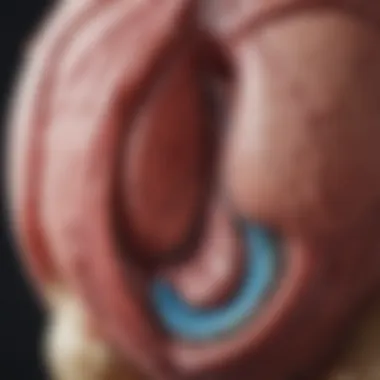Prostate Cancer in Women: An In-Depth Exploration


Intro
Prostate cancer is typically viewed through a male-centric lens, primarily due to the presence of the prostate gland in men. However, this perception oversimplifies a more nuanced dialogue regarding prostate-related conditions in women. This article seeks to illuminate the various dimensions of prostate cancer and its implications for women, particularly focusing on the female prostate and its connection to androgen-related cancers.
Research Overview
Key Findings
Emerging findings suggest that the female prostate, often referred to as the Skene's glands, plays a significant role in women's health. These glands, while smaller and less understood than the male prostate, may influence certain health conditions that share symptoms with prostate cancer. Current literature indicates potential overlaps in symptoms and treatment modalities, specifically regarding androgen levels and hormonal influences in women.
Additionally, some studies indicate that certain rare conditions, such as urethral cancers or even rare presentations of prostate cancer, can manifest in women, albeit exceedingly rare. Regular monitoring and understanding of these cases are paramount for timely intervention.
Study Methodology
The research derives from a collective analysis of peer-reviewed studies focusing on the female prostate and related cancers. Both qualitative and quantitative data were examined to derive insights from existing literature. Key databases such as PubMed and Google Scholar served as primary sources, while historical records were revisited to gain a comprehensive understanding of how perceptions of prostate-related ailments in women have evolved over time.
Background and Context
Historical Background
The historical context of prostate health in women is sparse. Traditionally, discussions have revolved around male health, leaving women's conditions underexplored. It wasn't until the late 20th century that researchers began acknowledging the female prostate and its potential health implications. This oversight has persisted, creating gaps in understanding and awareness about cancer in the context of women's health.
Current Trends in the Field
Today, there is a growing recognition of the complexities surrounding androgen-related cancers in women. Recent studies are beginning to shed light on how hormones influence cancer pathogenesis and disease progression. The dialogue surrounding the issue is slowly shifting towards a more inclusive narrative that considers the role of female anatomy and physiology in cancer research.
"Understanding the female prostate and its potential to develop cancer is crucial for addressing the broader landscape of cancer in women."
Epilogue
The examination of prostate cancer in women reveals a need for continued dialogue and research. The complexities of the female prostate and the potential links to various cancers underscore the importance of breaking traditional molds in cancer research. By focusing on gender-specific health needs, researchers and healthcare professionals can pave the way for more comprehensive treatment and diagnosis.
Understanding Prostate Cancer
Prostate cancer is a term often associated with men, but this article takes a different perspective by examining its relevance to women. Addressing the specific characteristics of prostate cancer is vital in an inclusive discussion about cancers affecting both sexes. Understanding prostate cancer requires a look into its definitions, epidemiology, and pathophysiology. As our knowledge of the female anatomy grows, it becomes essential to recognize the existence of structures analogous to the male prostate and how they may relate to cancer.
Definition and Characteristics
Prostate cancer typically refers to malignancies originating in the prostate gland, which is primarily found in men. However, females have a structure known as the female prostate or Skene's glands. These glands are located near the urethra and can play a role in sexual function. While the cancer occurring in these glands may not be identical to traditional prostate cancer, its study is paramount. It is crucial to acknowledge that adenocarcinomas, which are the most common forms of prostate cancer in men, may have counterparts in women that need careful dissection in further research. This section will explore how these definitions might evolve as we learn more about the female prostate.
Epidemiology
Epidemiological studies focus on the distribution and determinants of diseases in various populations. Awareness of epidemiology is key to understanding how often certain types of cancers occur in women. Current data suggests that conditions associated with androgen influence are not solely limited to men. Women may face similar risks, although the exact statistics are unclear. Understanding these rates is critical for healthcare providers, as it shapes screening practices and prevention efforts.
The epidemiological data on female gut, urethral, and vulvar cancers reveals the complexity of androgen-related malignancies.
Pathophysiology
Examining the pathophysiology of prostate cancer is essential to grasping the underlying mechanisms and biological processes involved in tumor development. In women, the roles of hormones such as estrogen and testosterone are significant. The presence of hormone receptors in women's prostate-like tissues suggests that the interplay of these hormones may contribute to disease progression. Research into the pathophysiology of cancers related to the female prostate offers insights that can help bridge gaps in knowledge and enhance treatment options.
The Female Prostate: An Overview
The female prostate, although less known than its male counterpart, plays a critical role in understanding prostate-related conditions in women. This section serves to illuminate the anatomy and functions of the female prostate, as well as the hormonal influences that may impact its health. In doing so, it provides insight into the potential overlap between prostate cancer in men and analogous conditions in women, thereby highlighting the need for heightened awareness and research in this area.


Anatomy and Function
The anatomy of the female prostate is intricate yet underexplored. It is composed of a group of glands located near the urethra, specifically the periurethral glands. These glands are responsible for producing a fluid that contributes to lubrication during sexual intercourse. Additionally, they play a minor role in the composition of urine, although their influence is not as pronounced as that of the male prostate gland.
Research into the function of the female prostate is still ongoing, but several studies have indicated that this structure may also produce prostate-specific antigen (PSA), a protein typically associated with male prostate health. The presence of PSA in women suggests that the female prostate could be significant in understanding certain medical conditions.
Hormonal Influences
Hormones significantly affect the functioning of the female prostate. The primary hormones involved are estrogen and testosterone. These hormones regulate various aspects of growth and functioning in reproductive tissues.
- Estrogen: This hormone is critical during various life stages for women, such as puberty and menopause. Changes in estrogen levels can impact the female prostate's glandular tissue and potentially contribute to pathological changes.
- Testosterone: Although considered a male hormone, it is present in women in lower concentrations. Research suggests that testosterone may influence the activity of the female prostate and could be associated with certain cancers.
This hormonal interplay is essential when considering the development of cancers related to the female prostate, such as adenocarcinoma. Understanding these influences is crucial for medical professionals and researchers aiming to develop accurate diagnostic and treatment strategies.
"Research into the female prostate is often overlooked, yet it holds valuable information for understanding broader cancer issues in women."
This overview underscores the importance of recognizing the female prostate's anatomy and hormonal influences. By doing so, we can enrich our understanding of prostate-related health concerns, ultimately paving the way for improved awareness and treatment options.
Cancers Related to the Female Prostate
Understanding cancers related to the female prostate is essential. This topic reveals the complexities and nuances that often go unrecognized in mainstream discussions about cancer. Since prostate cancer is predominantly associated with men, the implications for women are frequently overlooked. A comprehensive examination of this subject allows for better understanding of how similar pathologies can affect women, particularly in relation to the female prostate and its associated structures.
These cancers can significantly influence clinical presentations and therapeutic approaches. As healthcare providers and researchers expand their knowledge base, it becomes crucial to delineate how cancers in women may parallel those affecting men. This provides insights into potential treatment modalities and reinforces the need to profile these conditions accurately.
Adenocarcinoma of the Female Prostate
Adenocarcinoma of the female prostate, albeit rare, poses significant clinical challenges. This type of cancer originates from glandular tissue in the female prostate. It shares many characteristics with its male counterpart, including histological features. Recognizing adenocarcinoma early can lead to more effective management strategies. Symptoms can often be vague, resembling other less severe conditions, thus leading to delays in diagnosis.
Research indicates that hormone levels may influence the development of adenocarcinoma. A thorough understanding of hormonal interactions is vital for comprehending its origins. Understanding the unique aspects of patient presentations is important for clinicians trying to navigate this landscape.
Urethral Carcinoma
Urethral carcinoma represents another relevant cancer type associated with the female prostate. This malignancy arises in the lining of the urethra. It may manifest with symptoms such as difficulty urinating, changes in urinary stream, or blood in urine. Similar to prostate cancer in males, the etiology may involve genetic factors, exposure to carcinogens, and chronic irritation.
The disease is often insidious. Its symptoms might be mistaken for other urinary tract infections. This requires careful diagnostic evaluation. Urethral carcinoma's proximity to the female prostate means that surgical interventions might be complex, necessitating a multidisciplinary approach.
Vulvar and Vaginal Carcinomas
Vulvar and vaginal carcinomas also deserve consideration. While these cancers primarily arise in the vulva and vagina, their relationship to the female prostate is noteworthy. Hormonal contributions and structural similarities must be explored to understand their behavior comprehensively.
These cancers can present with local symptoms such as lesions, itching, or abnormal bleeding, which could be easily dismissed. Their connection to the female prostate could enhance understanding of their occurrence and possibly influence treatment approaches.
"Understanding the specific cancers related to the female prostate can lead to better diagnostic and treatment frameworks."
Symptoms and Diagnosis
Understanding the symptoms and diagnosis of prostate cancer in women is vital for several reasons. First, awareness of symptoms can lead to earlier detection, which is often critical for improving treatment outcomes. Many of the symptoms associated with prostate cancer can overlap with other conditions, making it essential to differentiate them accurately. This section outlines the key aspects of recognizing symptoms and the diagnostic approaches that follow. Effective diagnosis lays the groundwork for tailored treatment options and can improve quality of life for affected individuals.
Recognizing Symptoms
Identifying the symptoms of cancers related to the female prostate is paramount. Some common symptoms may include discomfort during urination, frequent urges to urinate, and pelvic pain. These symptoms can often be mistaken for benign conditions like infections or urinary tract issues. Therefore, understanding the context of these symptoms is crucial.
Additionally, some patients may experience systemic symptoms such as fatigue and unintended weight loss, which can be more general indicators of cancer. Recognizing these symptoms requires a comprehensive understanding of both the patient's medical history and the specific characteristics of their symptoms. Therefore, healthcare professionals must be educated on these signs to facilitate prompt diagnosis.
Diagnostic Approaches


Effective diagnostic techniques are key to confirming the presence of cancer and understanding its extent. Various methods exist, each with strengths and limitations.
Imaging Techniques
Imaging techniques, such as ultrasound and MRI, play a critical role in the diagnostic process. These techniques help visualize the anatomy of the pelvic region, revealing any abnormalities that could indicate a tumor’s presence. Ultrasound is often used because it is non-invasive, relatively affordable, and can provide real-time imaging information. On the other hand, MRI is more detailed and can help in staging the cancer, providing critical information on whether cancer has spread.
However, one of the drawbacks of imaging techniques is that they may sometimes fail to distinguish between benign and malignant growths without further analysis.
Biopsies and Pathology
Biopsies are a definitive method of diagnosing prostate cancer in women. This procedure involves taking a tissue sample from the suspected area and examining it under a microscope. The key characteristic of biopsies is their ability to offer a clear diagnosis by identifying cancerous cells. This method is considered standard in confirming cancer diagnosis.
A unique feature of biopsies is their comprehensive nature, as they can inform about the tumor's grade and aggressiveness. Yet, performing a biopsy carries potential risks, such as bleeding or infection, and may not be suitable for all patients depending on their health status.
"Early recognition and accurate diagnosis increase options for effective treatment and can drastically improve patient outcomes."
Treatment Modalities
The exploration of treatment modalities for prostate cancer in women is crucial. Understanding these options can directly influence outcomes and quality of life. Generally, treatment approaches for cancers involving the female prostate can be multifaceted. The choice of treatment depends upon various factors including the type and stage of cancer, the patient’s overall health, and personal preferences. This section discusses surgical methods, radiation therapy, hormone therapy, and chemotherapy as potential treatments, each important in their own right.
Surgical Options
Surgical intervention is often a primary method for treating localized cancers. In the context of prostate cancer in women, surgical options typically include:
- Prostatectomy: This involves the removal of the female prostate gland. It is feasible for localized adenocarcinoma of the female prostate, providing a potential cure.
- Lymphadenectomy: Frequently performed alongside radical prostatectomy, this involves the removal of nearby lymph nodes to evaluate cancer spread, which is critical for staging.
Surgery is beneficial as it can directly remove cancerous tissue. However, there are considerations to keep in mind. Potential risks include bleeding, infection, and impacts on nearby organs. The recovery period can also be challenging, necessitating thorough discussions between the healthcare team and the patient regarding potential outcomes and rehabilitation following surgery.
Radiation Therapy
Radiation therapy employs high-energy rays to destroy cancer cells or inhibit their growth. For women diagnosed with prostate cancer, radiation might be used as:
- Curative treatment: Especially in cases where surgery is not a suitable option or when cancer is detected at a later stage.
- Adjuvant treatment: Administered post-surgery to eliminate residual cancer cells.
Various techniques exist within radiation therapy such as external beam radiation and brachytherapy. The choice of method will depend on specific cancer characteristics and patient factors. Benefits of radiation therapy include the ability to target tumors specifically, minimizing damage to surrounding healthy tissue. However, side effects can include fatigue, skin irritation, and other localized symptoms. Each patient should have access to comprehensive guidance on the risks and expectations of radiation therapy.
Hormone Therapy
Hormone therapy is an important method in managing cancers that are hormone-sensitive. This treatment alters the body’s hormone levels to slow the growth of cancer cells. In the case of prostate cancer, androgen deprivation therapy (ADT) is common, often utilized for:
- Advanced stages of prostate cancer.
- Recurrence following initial treatments.
Forms of hormone therapy may include medications that block hormone production or stop hormones from acting on cancer cells. The significance of hormone therapy lies in its capability to control cancer progression effectively. However, patients might experience side effects including hot flashes, fatigue, and mood changes.
Chemotherapy
Chemotherapy uses drugs to kill fast-growing cancer cells throughout the body. It is generally not the first-line treatment for adenocarcinoma of the female prostate but may become relevant in certain circumstances:
- Spread of cancer beyond localized areas.
- Symptoms of advanced disease.
Chemotherapy can be administered in various schedules and combinations depending on the overall treatment plan. The potential efficacy of chemotherapy against aggressive cancer types makes it a pivotal option, though the side effects can be significant. Common effects include nausea, hair loss, and increased susceptibility to infections. Individualized care plans are essential to manage these issues effectively while aiming for the best possible outcomes for patients.
The integration of these treatment modalities aims to enhance patient care and survival outcomes. A comprehensive understanding of the available options facilitates informed decision-making for patients and their families.


Research Developments
Research on female prostate cancer is a rapidly evolving area. This topic is crucial because it explores a less understood aspect of cancer biology, particularly its implications for both diagnostics and treatment. Understanding these developments can lead to improved outcomes for patients and can challenge existing perceptions in medical practice.
Current Studies on Female Prostate Cancer
Research in this field has been limited historically. However, recent studies are beginning to illuminate the characteristics and behaviors of cancers associated with the female prostate. One notable study looked at the genetic and molecular markers of female prostate adenocarcinoma.
In 2023, significant findings from a collaborative research project aimed to characterize the histological features of this rare form of cancer. The results indicated potential similarities to its male counterpart, especially regarding the expression of certain androgen receptors. Other studies have highlighted the importance of identifying these genetic markers as they could guide personalized treatment options. Without evidence-based studies, these findings risk being unrecognized, leading to a gap in effective interventions for affected women.
Implications for Treatment
The implications of research developments on the treatment of female-related prostate cancers are profound. With advancements in understanding cancer-specific markers, targeted therapies can be developed to suit individual patient profiles. These new treatments promise to be more effective than the conventional options typically employed. For example, the use of hormone-blocking therapies, which have been successful in male prostate cancer patients, is now being studied for efficacy in women.
Moreover, ongoing clinical trials are exploring combinations of chemotherapy and hormone therapy, specifically focusing on survival rates and quality of life. As more data becomes available, the hope is to establish standardized treatment protocols that incorporate these promising therapies into clinical practice.
"The evolving landscape of female prostate cancer research instills hope for better diagnosis and treatment, highlighting the need for ongoing investigation in this overlooked area."
This knowledge transfer from ongoing studies to practical applications ultimately aims to enhance the effectiveness of cancer treatment for women, significantly impacting their quality of life. Researchers and clinicians must work together to ensure that these advances translate into clinical practice.
In summary, the research developments in this realm are not only raising awareness but also laying a foundation for future medical interventions.
Psychosocial Impact
The psychosocial impact of cancer is an essential aspect that must not be overlooked. Prostate cancer, while predominantly viewed through a clinical lens, profoundly affects patients' mental and emotional well-being. Understanding how the diagnosis and treatment alter a woman's daily life is imperative for providing comprehensive care. This section elucidates the specific dimensions of psychosocial impacts regarding prostate cancer in women, focusing on quality of life evaluations and support systems.
Quality of Life Evaluations
Quality of life (QOL) evaluations involve assessing how cancer influences various facets of a patient's existence. For women facing related forms of prostate cancer, QOL can be diminished due to symptoms, treatment side effects, and overall life changes. Factors such as pain, fatigue, psychological stress, and relationship dynamics play a significant role. Understanding these elements helps healthcare providers tailor interventions to enhance patient well-being.
For instance, studies have shown that women undergoing treatment for adenocarcinoma of the female prostate report increased levels of anxiety and depression compared to their healthy counterparts. Pain management, nutritional support, and psychological counseling are potential avenues for improving QOL post-diagnosis. Moreover, tools like the European Organization for Research and Treatment of Cancer (EORTC) QLQ-C30 questionnaire can help capture these complex elements in quantifiable terms.
"A holistic view of quality of life must be integrated into cancer care to support patients beyond just physical health."
Support Systems and Resources
Support systems are vital for anyone managing a cancer diagnosis. For women diagnosed with prostate-related cancers, these networks can include healthcare professionals, family, friends, and support groups. Tailored resources must address unique challenges and offer avenues for emotional support.
- Healthcare Professional Support: Access to oncologists, nurse navigators, and mental health counselors can provide critical guidance. Regular communication helps in adjusting treatments in response to emerging issues.
- Family and Friends: Meaningful connections greatly contribute to emotional resilience. Educating loved ones about the specific challenges may enhance their supportive role.
- Support Groups: These can be particularly beneficial, providing a platform for sharing experiences. Organizations such as the American Cancer Society offer programs specifically targeting women affected by urogenital cancers.
Ends and Future Directions
The exploration of prostate cancer in women demands a broad understanding of various interconnected factors. Recognizing the distinctions between male and female presentations of prostate-related diseases is crucial. This section emphasizes the significance of consolidating knowledge regarding the female prostate, related cancers, and emerging research trends. It paves the way toward understanding how prostate cancer impacts women and highlights necessary interventions in medical practice.
Summary of Key Findings
A comprehensive review of the article demonstrates that while prostate cancer is often seen as a male-centric disease, there exists a complex relationship regarding its implications for women. Key findings include:
- The presence of homologous structures in women, such as the female prostate, invites discussions on its potential oncological implications.
- Emerging studies reveal that adenocarcinomas and other forms of cancer, such as urethral carcinoma, might share pathophysiological characteristics.
- Psychological and social dimensions influence the quality of life for women diagnosed with these conditions.
These aspects converge to present a more nuanced picture of prostate cancer, suggesting an urgent need for increased awareness and research.
Areas for Further Research
Future research should be directed toward several critical areas:
- Understanding Hormonal Influences: Further investigations into how hormonal factors affect the development of prostate-related cancers in women are essential. A thorough grasp can lead to better preventive measures.
- Diagnostic Criteria Development: Establishing standardized guidelines for diagnosing prostate cancers and related conditions in women is vital. This could enhance early detection and treatment.
- Longitudinal Studies: There is a need for longitudinal studies that follow women diagnosed with these cancers to identify patterns, treatment responses, and long-term effects on health outcomes.
- Intersection with Other Cancers: Researching how prostate cancers in women overlap with other gynecological cancers could inform treatment strategies and improve patient management.
- Psycho-Social Research: Investigating the psychosocial impact of these diagnoses will better inform support systems and resources necessary for women navigating these conditions.
"The road ahead is challenging, yet it is filled with promise and opportunity for significant advancements in women's health."
The pursuit of knowledge in this area holds great potential not only for understanding mechanisms of disease but also for enhancing the quality of care for women affected.







